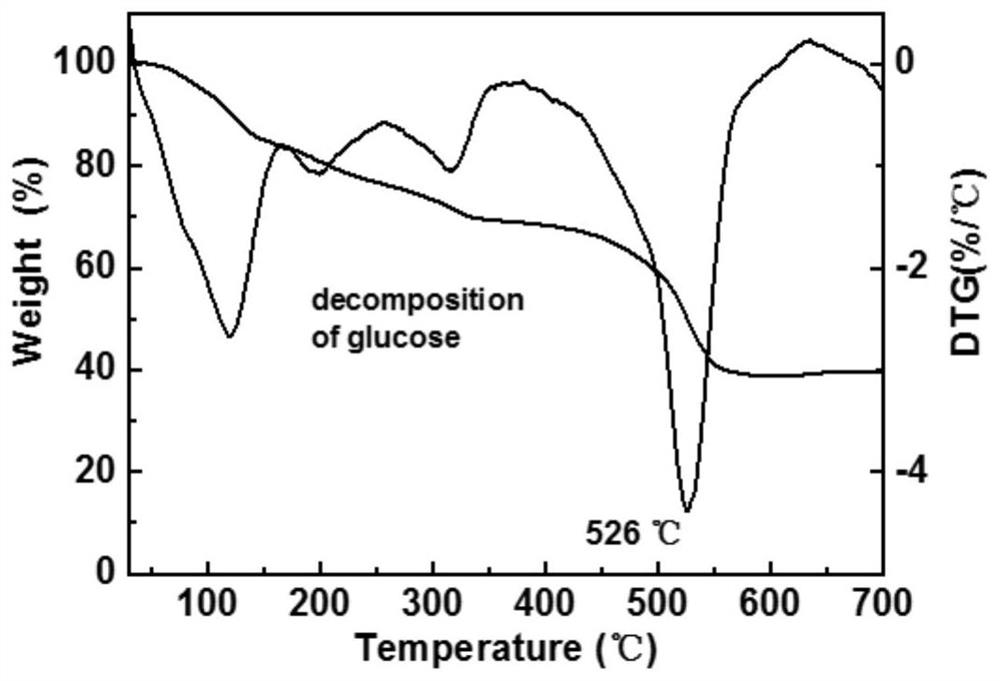Heterojunction nanomaterial diaphragm for lithium-sulfur battery and preparation method thereof
A technology of nanomaterials and lithium-sulfur batteries, applied in the direction of lithium batteries, battery components, non-aqueous electrolyte batteries, etc., can solve the problems of low utilization rate of active materials, kinetics of shuttle effect, difficulty in commercialization, etc., and achieve easy Effects of generalization, good kinetics and electrochemical performance, cheap raw materials
- Summary
- Abstract
- Description
- Claims
- Application Information
AI Technical Summary
Problems solved by technology
Method used
Image
Examples
Embodiment 1
[0021] Glucose and cobalt sulfate were formulated into an aqueous solution at a mass ratio of 0.25:1, and then sprayed into a dry powder at 150°C by spray drying. Place the obtained powder in the constant temperature zone of the tube furnace, raise the temperature to 600°C at 10°C / min under 200ml / min argon atmosphere, keep it warm for 2h, cool down to 350°C at a rate of 10°C / min, and then cool with the furnace to room temperature, the cobalt sulfide / cobalt oxide heterojunction is obtained. The prepared heterojunction nanomaterials and graphene were uniformly dispersed in ethanol, covered on the surface of the diaphragm by suction filtration, and dried at 60°C to obtain a multifunctional diaphragm with a modified layer. The thickness of the modification layer is 1-20 μm.
[0022] attached figure 1 It is the thermogravimetric curve of the precursor obtained by spraying. It can be found that the range of 50-400 °C is the decomposition range of glucose, and the process of carbot...
Embodiment 2
[0024] Glucose and cobalt sulfate were formulated into an aqueous solution at a mass ratio of 0.3:1, and then sprayed into a dry powder at 150°C by spray drying. Place the obtained powder in the constant temperature zone of the tube furnace, raise the temperature to 600°C at 10°C / min under 200ml / hydrogen atmosphere, keep it warm for 2h, cool down to 350°C at a rate of 10°C / min, and then cool to room temperature with the furnace , that is, cobalt sulfide / cobalt oxide heterojunction nanomaterials are obtained. The prepared heterojunction nanomaterials and graphene were uniformly dispersed in ethanol, covered on the surface of the diaphragm by suction filtration, and dried at 60°C to obtain a multifunctional diaphragm with a modified layer. The thickness of the modification layer is 1-20 μm.
Embodiment 3
[0026] Glucose and nickel sulfate were formulated into an aqueous solution at a mass ratio of 0.25:1, and then sprayed into a dry powder at 150°C by spray drying. Place the obtained powder in the constant temperature zone of the tube furnace, raise the temperature to 600°C at 10°C / min under 200ml / argon atmosphere, keep it warm for 2h, cool down to 350°C at a rate of 10°C / min, and then cool with the furnace to At room temperature, nickel sulfide / nickel oxide heterojunction nanomaterials are obtained. The prepared heterojunction nanomaterials and graphene were uniformly dispersed in ethanol, covered on the surface of the diaphragm by suction filtration, and dried at 60°C to obtain a multifunctional diaphragm with a modified layer. The thickness of the modification layer is 1-20 μm.
PUM
| Property | Measurement | Unit |
|---|---|---|
| thickness | aaaaa | aaaaa |
| thickness | aaaaa | aaaaa |
| current efficiency | aaaaa | aaaaa |
Abstract
Description
Claims
Application Information
 Login to View More
Login to View More - R&D
- Intellectual Property
- Life Sciences
- Materials
- Tech Scout
- Unparalleled Data Quality
- Higher Quality Content
- 60% Fewer Hallucinations
Browse by: Latest US Patents, China's latest patents, Technical Efficacy Thesaurus, Application Domain, Technology Topic, Popular Technical Reports.
© 2025 PatSnap. All rights reserved.Legal|Privacy policy|Modern Slavery Act Transparency Statement|Sitemap|About US| Contact US: help@patsnap.com



